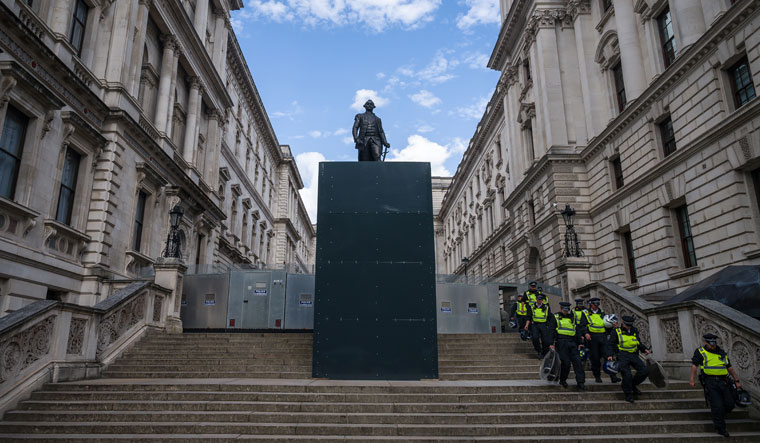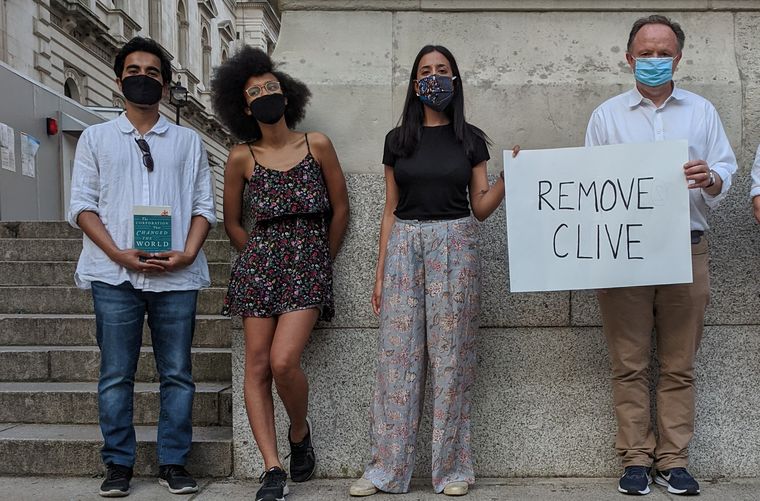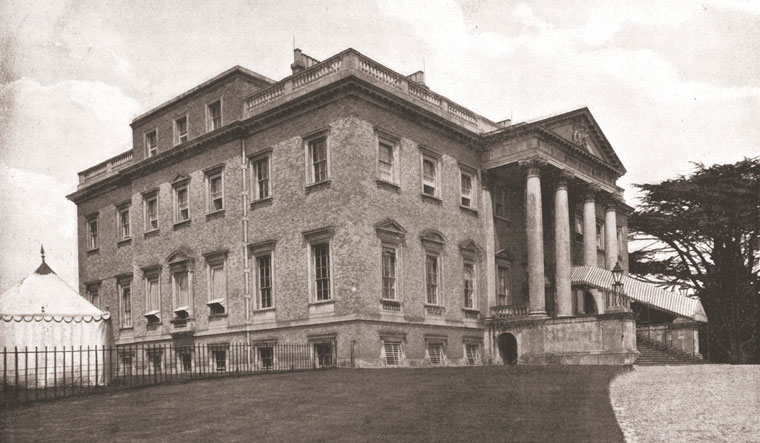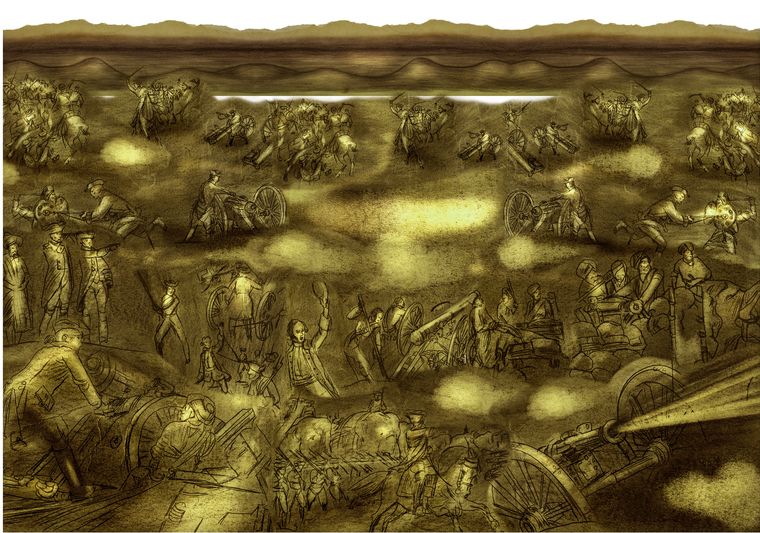It began, as change often does now, with a burst of idealism and an online petition. The statue of slave trader Edward Colston had just found a permanent place at the bottom of the sea in Bristol. History had been made. It had been corrected. There was a rush of revolution. And, swept up in the Black Lives Matter (BLM) movement, Ameya Tripathi, Meera Somji and Rhianna Ilube—British, but inheriting stories of the empire—launched a petition to topple India’s original bad guy: Robert Clive. “It sometimes takes pulling down a statue,” says Somji, studying gender at the London School of Economics, “or removing it to shake people.”
This is a new generation discovering the past through the prism of the present, probably spurred by this pause of a pandemic, to urgently right the wrongs of history. From America to Australia, the BLM movement is raging with this sense of urgency and is forcing countries to confront racism and imperialism. It is a revolt—the kind that has the possibility to ensure that the past is more inclusive, fairer and is not only the version of the victor. In a Game of Thrones sort of frenzy, statues are coming down and heroes are turning into villains. The message is clear: heroes of the past must subscribe to the 21st century sense of justice to be on pedestals.
In Belgium, statues of Leopold II, the coloniser king, have been pulled down; in the US, some memorials to the Confederacy, which supported slavery, have disappeared, and in the heart of London there is Clive, still standing.
One of the first Indian words to enter the English dictionary was loot. Clive can single-handedly take credit for that. The weight of the word—as well as the enormity of it—is on display at Powis Castle in Wales, which has the largest private collection of Indian artefacts in private hands in Britain, courtesy Clive and his eldest son, Edward. But it goes beyond just plunder. Clive systematically presided over the first corporate takeover of a country. The East India Company (EIC) stripped Bengal of its wealth to turn Britain into a rich country and later an empire. His first loot is valued at £250 million in today’s money.
Clive began his career in the EIC as a writer and rose to become the first governor of Bengal. Under him, the EIC became rulers. He installed a pliant nawab in Bengal—Mir Jafar—with the Battle of Plassey in 1757, because the earlier nawab Siraj-ud Daula had gone rogue. But his masterstroke was that he extracted the diwani—the right to collect revenue of Bengal, Bihar and Orissa—from the Mughal Emperor Shah Alam II. In the hands of unscrupulous company officials, this triggered the famine of Bengal. (Clive knew that once the news of the diwani reached England, the price of the EIC stocks would soar. He wrote to his stockbroker to ensure that he profited from it). “There is nothing redeemable about him,” says historian Lakshmi Subramanian, who wrote History of India 1701-1857.
Yet, Clive stands tall right in front of the Foreign and Commonwealth Office in Whitehall, a hero and a constant reminder of the empire, the plunder and the ruin. Prime Minister Boris Johnson walks past his statue every time he heads to the park behind 10 Downing Street for a walk. “This is not where he belongs,” says historian William Dalrymple, who has been vocal about removing the statue.
The incongruity of Clive having pride of place, in a tourist spot and right in the heart of British government, stands out. Former high commissioner of India to the UK Navtej Sarna had tweeted: “Whitehall statue of so-called “Clive of India” irked me each time I went to British #FCO. It needs to go. The Raj was not ‘some enormous rose-tinted Merchant Ivory film writ large over the plains of Hindustan, all parasols and Simla tea parties’.”
Lok Sabha MP Shashi Tharoor’s tweet to London Mayor Sadiq Khan on removing the Clive statue triggered public outrage, which has added to the momentum of the movement to get the statue out. “His statue there is a daily affront to people from the former colonies,” says Tharoor. “Removing Clive is a powerful symbol. Don’t forget the Brits actually called him ‘Clive of India’. So, in many ways, he is emblematic of the Raj and all its misdeeds.”
Unlike the other instances of instant justice, the Clive statue will be removed in a civilised manner. There will be debate, discussion, resistance, and a long wait. But it does offer hope that for once there will be real conversation. The petition demand is to move the statue to a museum, where future generations can fully understand the extent of Clive’s legacy. “It will not happen overnight,” said Murad Qureshi, a UK Labour politician who has chosen to lead this battle from the front. Qureshi went through school without learning about the empire; it was at the dinner table where he heard Clive’s name. “Most people who go past it [the statue], don’t know who this guy is,” says Qureshi. “But for those of us who do, we are offended.”
Thanks to the BLM movement, Britain, for the first time in centuries, might be forced to acknowledge its past in an unvarnished way—to actually have a conversation about plunder, loot and empire, a word that has lost its punch. “The campaign to remove it has attracted 85,000 signatures on its petition in one month,” says Tharoor. “As the numbers grow, I hope it will be difficult for the British government to ignore this demand.” And the debate this time has gone beyond the government. Public opinion matters. “I’m afraid British historical amnesia has convinced too many of them that they have nothing to apologise for,” says Tharoor. “So they are unlikely to act, even to remove the statue, unless the facts are impressed upon them.”
But this is not the first time that Britain has faced resistance about the empire from within. The Rhodes Must Fall movement against Cecil Rhodes, who is like Clive in terms of pushing for profit, rocked Oxford University in 2016, a year after his statue was removed from the University of Cape Town. It still stands outside Oriel College in the heart of Oxford.
But at a time when the world is reassessing the past so that it reflects a more just world today, the stubbornness of not removing the statue is troubling. In Shrewsbury, Shropshire, where Clive was born, two petitions to remove his statue sparked a debate. With the local council voting to keep the statue, it continues to dominate the skyline. The governing body of Oriel College, however, has voted in favour of removing the Rhodes statue.
That offers hope. The effort to talk about the silences in British history is coming from within the country. People under 30 are re-examining the past through books like Dalrymple’s The Anarchy: The East India Company, Corporate Violence, and the Pillage of an Empire—a mass market seller that was read by both former US president Barack Obama and Pakistan Prime Minister Imran Khan—or Tharoor’s An Era of Darkness: The British Empire in India. The EIC story, largely forgotten, is being rediscovered.
Clive was not a name Somji had ever heard before. “I was meeting my family a few years ago and they told me to meet at Clive,” she says. “I thought it was odd, who is Clive of India? It was like one of those characters in Lagaan.” Somji is not alone. Clive has vanished from British curriculum for the past 40 years, and Tharoor has been pushing for the empire to be included in the British curriculum.
For the BLM movement to go beyond symbolism, this has to happen. Especially for Britain, where the empire has been normalised. “Clive is different from Colston,” says Tripathi, who is pursuing his PhD in English and Comparative Literature from Columbia University. “He is different from Churchill; he is a privateer. It is more politically palatable for a certain white constituency, conservative or liberal, to say that he was hated in Britain and Bengal. But as a British citizen, whenever I see the statue at Whitehall, I don’t feel offended; I feel complicit.”
Clive and his adventures had become an inspiration. He fuelled the idea of the empire. It was where fortunes were made. He was received by the king. He became an MP from Shrewsbury. Later, he became Baron Clive of Plassey in Ireland’s County Clare—a title he proposed himself. The Irish estate brought him £2,000 per annum, Clive writes. His life in India was the stuff of legends. In Corsica, Napoleon dreamt of being a nabob. Prime minister William Pitt the Elder referred to Clive as the heaven-born general.
His wealth, which was obviously not amassed through kosher means, bought him power. The sheer magnitude of what he had can be judged by just a box that he sends to his wife, Margaret, in 1765. It contains, he writes, diamonds, rubies and pearls amounting to 42,000 Arcot rupees. A large transparent diamond of 20 rattis (one ratti is just under a carat), a diamond ring, 20 diamond drops, one ruby ring set with diamonds and 103 pearls. The invoice does not contain the 22 loose diamonds, he writes. This is just the tip of his vast fortune. Over the years, he acquired grand houses. His wife became a patron, so powerful that Mozart performed in their home. And when Clive sailed back to India in 1764, he had an orchestra on his ship.
He carted away everything—money, bejewelled flasks, hookahs, the palanquin that Siraj sat on. His son Edward, who was governor of Madras, even took Tipu Sultan’s horse back. Many of the artefacts that fill museums across the UK belong to the family. And in many of them, he is still Clive of India. The loot is treasure and how he acquired it does not even impact the countless who troop through the corridors of museums marvelling at them.
And increasingly, he might be the perfect test case to talk about the empire. Churchill may be its poster-boy—“a monster”, as Tharoor puts it—but he was a prime minister. He had been elected. His statue, how much ever it offends the colonies, was voted in with popular appeal. Clive’s was not.
Clive’s statue was hoisted up in 1911 by Lord Curzon who wanted to shore up an empire that was on its last legs. When he died, Clive was the most hated man in Britain, a biographer says. “Clive was regarded as a criminal in his lifetime,” says Dalrymple. “He died from his own hand, in the immediate aftermath of a massive parliamentary debate on whether he was a crook. He actually escaped full censure but the whole thing was incredibly bruising for him. He went home the night of the debate not knowing whether he was going to wake up with a penny in the morning.” Clive was buried in an unmarked grave in Shropshire in the dead of the night. He was 49.
In his defence before the committee, he had said, “Presents in India are coeval with the Company…. There has been no commander of his Majesty’s Squadron, nor a commander of His Majesty’s Land Forces nor a governor nor any chief who has not received presents.” An argument that is bought. As a committee member acknowledges at the end of the debate, Clive did contribute to the country. This is why Clive’s statue needs to go even more than Churchill’s. Despite the scandal, Clive was corrupt, but had respect. He still does. Even on websites of the National Trust, Clive is still very much a name that matters.
In a world where companies are being increasingly pressured to be ethical; where the Chinese government’s pushing of an economic agenda is being seen as neo-colonialism; and security concerns over Huawei are being debated as an assault on sovereignty; can Clive still stand? It is unlike the demand for an apology for Jallianwala Bagh, which was for the action of General Reginald Dyer. Clive represents the empire. He founded it.
“History has a tendency to catch up,” says author Sudeep Chakravarti. “But it’s up to a particular country’s citizens to do what they wish with statues, memories and histories. Britain is a country built on myth, cruelty and commerce, much like modern Belgium, which still has several statues of Leopold II.” This is at the heart of the battle to remove Clive’s statue. How does Britain see itself? Post Brexit and in a pandemic-stricken world with hyper nationalism, any conversation on colonisation will be difficult, dirty and divisive. “I believe if you are a mature postcolonial power, you should be able to reconcile with the history that is ignominious,” says Subramanian.
But it will not be easy. Change in institutional Britain happens slowly. Germany is the only country in the west that has dealt with its Nazi past. “The imperialist history of Britain runs so deep. There will be resistance,” says Ilube, who along with Somji founded A History of Everything Else, an online platform, to research and share untaught stories of the empire. “Because it is very difficult to understand what Britain is if we are ashamed of the imperialist past.”
The conversation about the empire has so far been led by those who felt the weight of it the most—who came in last. And the immigrant debate is a very dangerous one. “It is very different for us,’’ says Robert Fowke, writer and Clive’s descendant. “You haven’t had this immigration into India that we have had into Britain. But if you, say, had a population which was European and discontented, you would need to integrate their historical narrative with yours. We have the same problem. The problem is if you are from an Indian background or an African background, then Clive is not an ancestor. There is a lack of belonging.”
At Berkley Square, in London, stands one of his houses that Clive refurbished to demonstrate himself as a man of taste while he stripped Bengal; a blue plaque outside it describes him as a soldier. Qureshi wants that corrected. “He was a mercenary,” he says.
In the US, Woodrow Wilson’s name is being axed from institutions; Dixie Chicks will now onwards be simply known as The Chicks; and the term master bedroom has been expunged. The politically correct term is primary. The cultural landscape is being transformed to acknowledge the uncomfortable silence of the past. For Clive, vocabulary must change again. An Indian word that has now become English, loot must accompany each picture from his collection, each object in Powis Castle and especially under his statue when it does go to the museum.








